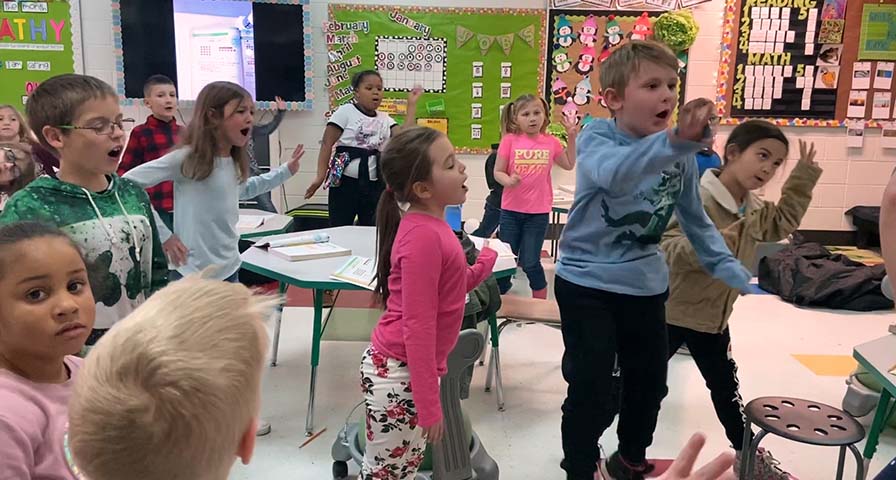Originally published Jan. 31, 2020 by 12WBOY.com.
By Shayla Klein
Andrea Goff’s first grade classroom at Ruffner Elementary School is not what you would expect. Instead of desks lined neatly in rows, kids sit at round tables, and some children sit on small exercise ball chairs. Instead of sitting quietly and working on worksheets, kids are playing games and shouting and moving around. But Joshua Grant, Physical Education Coordinator at the West Virginia Department of Education, said that Andrea Goff is one of the best teachers at adding physical activity to the classroom, and in fact, she teaches other teachers across the state to do what she does.
“Andrea just constantly integrates physical activity throughout the day. It’s seamless, her transitions are minimal, and the kids are just excited to learn,” said Grant.
 Almost everything Goff’s students do in the classroom has movement attached to it. As they work on addition problems, she gives them hand motions and chants to learn how to put together a simple equation. Sometimes, she’ll add in accents or tell them to do ten jumping jacks to learn how to count to ten. The movement, she says, helps her students memorize things.
Almost everything Goff’s students do in the classroom has movement attached to it. As they work on addition problems, she gives them hand motions and chants to learn how to put together a simple equation. Sometimes, she’ll add in accents or tell them to do ten jumping jacks to learn how to count to ten. The movement, she says, helps her students memorize things.
“My math scores have improved since my first year of teaching through the roof,” said Goff, “They’re so focused on the movements that they’re not even realizing that they’re learning.”
Ruffner Elementary School adds a few different ways for students to “get the wiggles out.” They have a separate room called the Focus Room where students can go and exercise when a student feels distracted and needs a “brain break.”
“Walk into any classroom and I don’t expect to see rows of kids sitting the proper way,” said Henry Nearman, Principal at Ruffner Elementary, “How many of us are sitting back straight with a book in front of us? Most of the time, we’re laying on the couch or in a comfortable chair. Why not do that for our students?”
It’s not just Ruffner Elementary that is trying out these new techniques. It’s part of a new initiative happening across the country where teachers are incorporating physical activity in their lessons, and the West Virginia Department of Education is encouraging teachers to give it a try.
West Virginia has the second-highest rate of childhood obesity in the nation, and adding more exercise to the school day could help lower that rate. The Center for Disease Control (CDC) recommends that kids get at least an hour of exercise every day, but nearly 75% of kids don’t. Researchers at the CDC say that adding physical activity to the classroom can help close the gap for kids who aren’t getting enough exercise.
“Some of the things that they’re facing today are things that are really this generation challenges, which the biggest thing is the digital age and electronics,” said Sarah Lee, Lead Health Scientist at the CDC, “That is their norm that they live with and so that becomes more attractive than being physically active for example.”
The West Virginia Prevention Research Center decided to do their own study on children’s physical activity with a grant from the CDC. The project, called Activate!, used FitBits to track how increasing physical activity can affect test scores. Researchers split 33 schools into three groups randomly—one to study physical activity in the classroom, one for activity outside of school, and a control group. Preliminary results have been positive so far.
In the school intervention group, teachers were trained to add physical activity to the classroom using a tool kit developed by the researchers. The tool kit was designed to be inexpensive to accommodate for schools with tight budgets, and included simple items like Chinese jump ropes. With this, teachers were able to nearly double the time kids spent being physically active at school.
“One thing we wanted to focus on was making physical activity enjoyable, because at this early age, you don’t want them to think of it as a chore or that it’s exercise or something I don’t want to do,” said Nancy O’Hara Tompkins, Co-Investigator at the West Virginia Prevention Research Center.
One challenge teachers and schools might face in adding physical activity is that it would cut down on academic time, but Lee said that a majority of the studies on adding that extra time for physical activity show that students perform better despite the decrease in lecture time.
“We have not found studies that show that it negatively affects academic success,” said Lee.
Seeking IHT Spirit System information?




